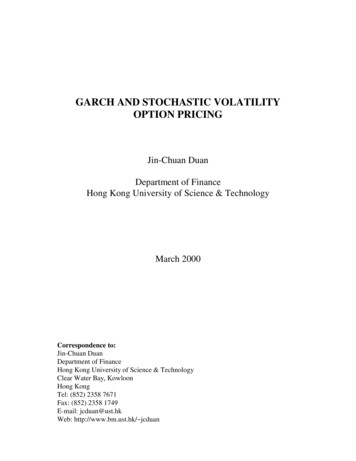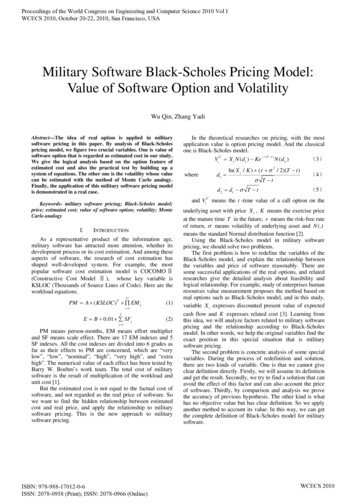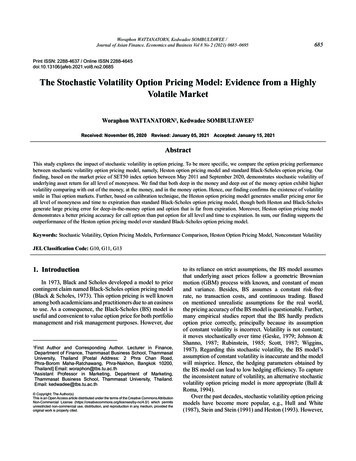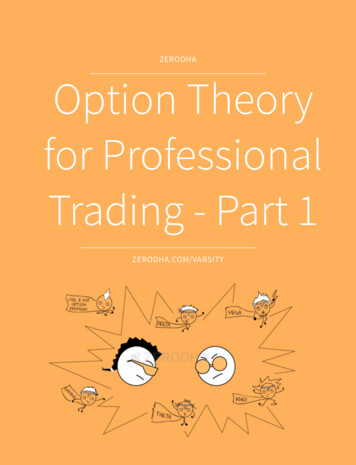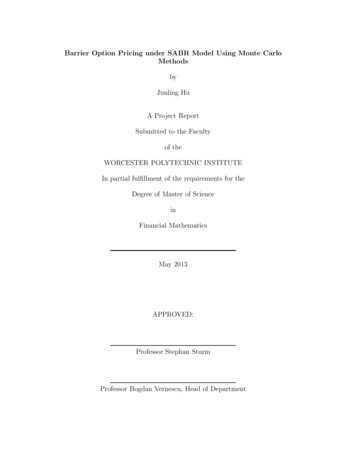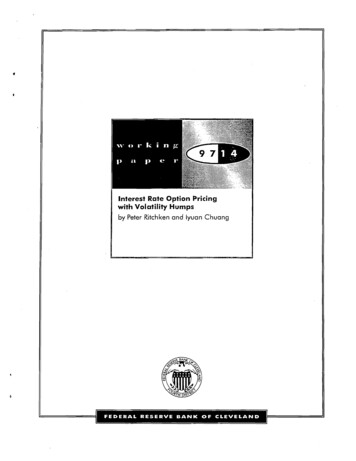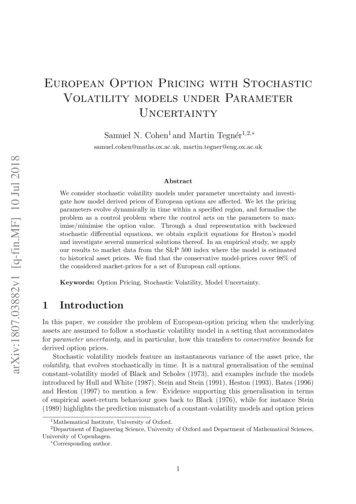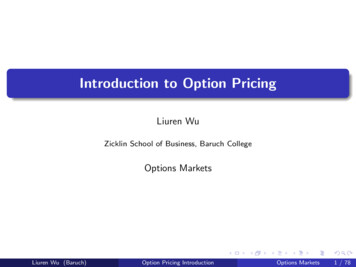
Transcription
.Introduction to Option PricingLiuren WuZicklin School of Business, Baruch CollegeOptions Markets. .Liuren Wu (Baruch)Option Pricing Introduction. . . . . . . . . . . . . . . . . . . . . . . . . . .Options Markets. . . . .1 / 78
Outline1.General principles and applications2.Illustration of hedging/pricing via binomial trees3.The Black-Merton-Scholes model4.Introduction to Ito’s lemma and PDEs5.Real (P) v. risk-neutral (Q) dynamics6.implied volatility surface. .Liuren Wu (Baruch)Option Pricing Introduction. . . . . . . . . . . . . . . . . . . . . . . . . . .Options Markets. . . . .2 / 78
Review: Valuation and investment in primary securitiesThe securities have direct claims to future cash flows.Valuation is based on forecasts of future cash flows and risk:DCF (Discounted Cash Flow Method): Discount time-series forecastedfuture cash flow with a discount rate that is commensurate with theforecasted risk.We diversify as much as we can. There are remaining risks afterdiversification — market risk. We assign a premium to the remainingrisk we bear to discount the cash flows.Investment: Buy if market price is lower than model value; sell otherwise.Both valuation and investment depend crucially on forecasts of future cashflows (growth rates) and risks (beta, credit risk). .Liuren Wu (Baruch)Option Pricing Introduction. . . . . . . . . . . . . . . . . . . . . . . . . . .Options Markets. . . . .3 / 78
Compare: Derivative securitiesPayoffs are linked directly to the price of an “underlying” security.Valuation is mostly based on replication/hedging arguments.Find a portfolio that includes the underlying security, and possiblyother related derivatives, to replicate the payoff of the target derivativesecurity, or to hedge away the risk in the derivative payoff.Since the hedged portfolio is riskfree, the payoff of the portfolio can bediscounted by the riskfree rate.No need to worry about the risk premium of a “zero-beta” portfolio.Models of this type are called “no-arbitrage” models.Key: No (little) forecasts are involved. Valuation is based, mostly, oncross-sectional comparison.It is less about whether the underlying security price will go up or down(forecasts of growth rates /risks), but about the relative pricing relationbetween the underlying and the derivatives under all possible scenarios. .Liuren Wu (Baruch)Option Pricing Introduction. . . . . . . . . . . . . . . . . . . . . . . . . . .Options Markets. . . . .4 / 78
Readings behind the technical jargons: P v. QP: Actual probabilities that earnings will be high or low, estimated based onhistorical data and other insights about the company.Valuation is all about getting the forecasts right and assigning theappropriate price for the forecasted risk — fair wrt future cashflows(and your risk preference).Q: “Risk-neutral” probabilities that one can use to aggregate expectedfuture payoffs and discount them back with riskfree rate.It is related to real-time scenarios, but it is not real-time probability.Since the intention is to hedge away risk under all scenarios anddiscount back with riskfree rate, we do not really care about the actualprobability of each scenario happening.We just care about what all the possible scenarios are and whether ourhedging works under all scenarios.Q is not about getting close to the actual probability, but about beingfair/consistent wrt the prices of securities that you use for hedging. . . . . . . . . . . . . . .Associate P with time-series forecasts and Q withcross-sectional. . . . . . . . . . . . . . . . .LiurenWu (Baruch)Option Pricing IntroductionOptions Marketscomparison. . . . .5 / 78
A Micky Mouse exampleConsider a non-dividend paying stock in a world with zero riskfree interest rate.Currently, the market price for the stock is 100. What should be the forwardprice for the stock with one year maturity?The forward price is 100.Standard forward pricing argument says that the forward price shouldbe equal to the cost of buying the stock and carrying it over tomaturity.The buying cost is 100, with no storage or interest cost or dividendbenefit.How should you value the forward differently if you have inside informationthat the company will be bought tomorrow and the stock price is going todouble?Shorting a forward at 100 is still safe for you if you can buy the stockat 100 to hedge. .Liuren Wu (Baruch)Option Pricing Introduction. . . . . . . . . . . . . . . . . . . . . . . . . . .Options Markets. . . . .6 / 78
Investing in derivative securities without insightsIf you can really forecast (or have inside information on) future cashflows,you probably do not care much about hedging or no-arbitrage pricing.What is risk to the market is an opportunity for you.You just lift the market and try not getting caught for insider trading.If you do not have insights on cash flows and still want to invest inderivatives, the focus does not need to be on forecasting, but oncross-sectional consistency.No-arbitrage pricing models can be useful.Identifying the right hedge can be as important (if not more so) asgenerating the right valuation. .Liuren Wu (Baruch)Option Pricing Introduction. . . . . . . . . . . . . . . . . . . . . . . . . . .Options Markets. . . . .7 / 78
What are the roles of an option pricing model?. Interpolation and extrapolation:1Broker-dealers: Calibrate the model to actively traded option contracts,use the calibrated model to generate option values for contractswithout reliable quotes (for quoting or book marking).Criterion for a good model: The model value needs to match observedprices (small pricing errors) because market makers cannot take bigviews and have to passively take order flows.Sometimes one can get away with interpolating (linear or spline)without a model.The need for a cross-sectionally consistent model becomes stronger forextrapolation from short-dated options to long-dated contracts, or forinterpolation of markets with sparse quotes.The purpose is less about finding a better price or getting a betterprediction of future movements, but more about making sure theprovided quotes on different contracts are “consistent” in the sensethat no one can buy and sell with you to lock in a profit on you. .Liuren Wu (Baruch)Option Pricing Introduction. . . . . . . . . . . . . . . . . . . . . . . . . . .Options Markets. . . . .8 / 78
What are the roles of an option pricing model?. Alpha generation2Investors: Hope that market price deviations from the model “fairvalue” are mean reverting.Criterion for a good model is not to generate small pricing errors, butto generate (hopefully) large, transient errors.When the market price deviates from the model value, one hopes thatthe market price reverts back to the model value quickly.One can use an error-correction type specification to test theperformance of different models.However, alpha is only a small part of the equation, especially forinvestments in derivatives. .Liuren Wu (Baruch)Option Pricing Introduction. . . . . . . . . . . . . . . . . . . . . . . . . . .Options Markets. . . . .9 / 78
What are the roles of an option pricing model?. Risk hedge and management:Hedging and managing risk plays an important role in derivatives.Market makers make money by receiving bid-ask spreads, but optionsorder flow is so sparse that they cannot get in and out of contractseasily and often have to hold their positions to expiration.3Without proper hedge, market value fluctuation can easily dominatethe spread they make.Investors (hedge funds) can make active derivative investments basedon the model-generated alpha. However, the convergence movementfrom market to model can be a lot smaller than the market movement,if the positions are left unhedged. — Try the forward example earlier.The estimated model dynamics provide insights on how tomanage/hedge the risk exposures of the derivative positions.Criterion of a good model: The modeled risks are real risks and are theonly risk sources.Once one hedges away these risks, no other . riskis left. . . . . . . . . . . . . . . . .Liuren Wu (Baruch)Option Pricing Introduction. . . . . . . . . . . . .Options Markets. . .10 / 78.
What are the roles of an option pricing model?. Answering economic questions with the help of options observations4Macro/corporate policies interact with investor preferences andexpectations to determine financial security prices.Reverse engineering: Learn about policies, expectations, andpreferences from security prices.At a fixed point in time, one can learn a lot more from the largeamount of option prices than from a single price on the underlying.Long time series are hard to come by. The large cross sections ofderivatives provide a partial replacement.The Breeden and Litzenberger (1978) result allows one to infer therisk-neutral return distribution from option prices across all strikes at afixed maturity. Obtaining further insights often necessitates morestructures/assumptions/an option pricing model.Criterion for a good model: The model contains intuitive, easilyinterpretable, economic meanings. .Liuren Wu (Baruch)Option Pricing Introduction. . . . . . . . . . . . . . . . . . . . . . . . . . .Options Markets. . . . .11 / 78
Forward pricingTerminal Payoff: (ST K ), linear in the underlying security price (ST ).No-arbitrage pricing:Buying the underlying security and carrying it over to expiry generatesthe same payoff as signing a forward.The forward price should be equal to the cost of the replicatingportfolio (buy & carry).This pricing method does not depend on (forecasts) how the underlyingsecurity price moves in the future or whether its current price is fair.but it does depend on the actual cost of buying and carrying (not allthings can be carried through time.), i.e., the implementability of thereplicating strategy.Ft,T St e (r q)(T t) , with r and q being continuously compounded rates ofcarrying cost (interest, storage) and benefit (dividend, foreign interest,convenience yield).When arbitrage trading does not work, q can be traded as a “convenience. . . . . . . . . . . . . . .yield,” or a prediction of future spot movements. . . . . . . . . . . . . . . . .Liuren Wu (Baruch)Option Pricing IntroductionOptions Markets. . . .12 / 78
Option pricingTerminal Payoff: Call — (ST K ) , put — (K ST ) .No-arbitrage pricing:Can we replicate the payoff of an option with the underlying security sothat we can value the option as the cost of the replicating portfolio?Can we use the underlying security (or something else liquid and withknown prices) to completely hedge away the risk?If we can hedge away all risks, we do not need to worry about riskpremiums and one can simply set the price of the contract to the valueof the hedge portfolio (maybe plus a premium).In most practical situations, options cannot be replicated by the underlying— Options are useful and informative about (i) expectations of the future(ii) risk premiums.The difficulty lies in how to separate the two. .Liuren Wu (Baruch)Option Pricing Introduction. . . . . . . . . . . . . . . . . . . . . . . . . . .Options Markets. . . . .13 / 78
Another Mickey Mouse example: A one-step binomial treeObservation: The current stock price (St ) is 20.The current continuously compounded interest rate r (at 3 month maturity)is 12%. (crazy number from Hull’s book).Model/Assumption: In 3 months, the stock price is either 22 or 18 (nodividend for now).St 20Comments: PPPPST 22ST 18Once we make the binomial dynamics assumption, the actual probability ofreaching either node (going up or down) no longer matters.We have enough information (we have made enough assumption) to priceoptions that expire in 3 months.Remember: For idealistic derivative no-arbitrage pricing, what matters is thelist of possible scenarios, but not the actual probability of each scenariohappening. . . . . . . . . . . . . . . . . .Liuren Wu (Baruch)Option Pricing Introduction. . . . . . . . . . . . .Options Markets. . .14 / 78.
A 3-month call optionConsider a 3-month call option on the stock with a strike of 21.Backward induction: Given the terminal stock price (ST ), we can computethe option payoff at each node, (ST K ) .The zero-coupon bond price with 1 par valueBT ST Bt 0.9704 cT QSt 20QQct ?Q BT ST cT is: 1 e .12 .25 0.9704.12211180Two angles:Replicating: See if you can replicate the call’s payoff using stock and bond. If the payoffs equal, so does the value.Hedging: See if you can hedge away the risk of the call using stock. Ifthe hedged payoff is riskfree, we can compute the present value usingriskfree rate. . . . . . . . . . . . . . . .Liuren Wu (Baruch)Option Pricing Introduction. . . . . . . . . . . . .Options Markets. . . . .15 / 78
ReplicatingBT 1 ST 22Bt 0.9704 cT 1QSt 20QQct ?Q BT 1ST 18cT 0Assume that we can replicate the payoff of 1 call using share of stock andD par value of bond, we have1 22 D1,0 18 D1.Solve for : (1 0)/(22 18) 1/4. Change in C/Change in S,a sensitivity measure.Solve for D: D 14 18 4.5 (borrow).Value of option value of replicating portfolio 14 20 4.5 0.9704 0.633. .Liuren Wu (Baruch)Option Pricing Introduction. . . . . . . . . . . . . . . . . . . . . . . . . . .Options Markets. . . . .16 / 78
HedgingBT 1 ST 22Bt 0.9704 cT 1QSt 20QQct ?Q BT 1ST 18cT 0Assume that we can hedge away the risk in 1 call by shorting share ofstock, such as the hedged portfolio has the same payoff at both nodes:1 22 0 18.Solve for : (1 0)/(22 18) 1/4 (the same): Change in C/Change in S, a sensitivity measure.The hedged portfolio has riskfree payoff: 1 41 22 0 14 18 4.5.Its present value is: 4.5 0.9704 4.3668 1ct St .ct 4.3668 St 4.3668 14 20 0.633. .Liuren Wu (Baruch)Option Pricing Introduction. . . . . . . . . . . . . . . . . . . . . . . . . . .Options Markets. . . . .17 / 78
One principle underlying two anglesIf you can replicate, you can hedge:Long the option contract, short the replicating portfolio.The replication portfolio is composed of stock and bond.Since bond only generates parallel shifts in payoff and does not play any rolein offsetting/hedging risks, it is the stock that really plays the hedging role.The optimal hedge ratio when hedging options using stocks is defined as theratio of option payoff change over the stock payoff change — Delta.Hedging derivative risks using the underlying security (stock, currency) iscalled delta hedging.To hedge a long position in an option, you need to short delta of theunderlying.To replicate the payoff of a long position in option, you need to longdelta of the underlying. .Liuren Wu (Baruch)Option Pricing Introduction. . . . . . . . . . . . . . . . . . . . . . . . . . .Options Markets. . . . .18 / 78
The limit of delta hedgingDelta hedging completely erases risk under the binomial model assumption:The underlying stock can only take on two possible values.Using two (different) securities can span the two possible realizations.We can use stock and bond to replicate the payoff of an option.We can also use stock and option to replicate the payoff of a bond.One of the 3 securities is redundant and can hence be priced by theother two.What will happen for the hedging/replicating exercise if the stock can takeon 3 possible values three months later, e.g., (22, 20, 18)?It is impossible to find a that perfectly hedge the option position orreplicate the option payoff.We need another instrument (say another option) to do perfecthedging or replication. .Liuren Wu (Baruch)Option Pricing Introduction. . . . . . . . . . . . . . . . . . . . . . . . . . .Options Markets. . . . .19 / 78
Introduction to risk-neutral valuationp BT 1 ST 22Bt 0.9704 QQSt 20QQ BT 11 pST 18Compute a set of artificial probabilities for the two nodes (p, 1 p) suchthat the stock price equals the expected value of the terminal payment,discounted by the riskfree rate.20 0.9704 (22p 18(1 p)) p 20/0.9704 1822 18 0.6523Since we are discounting risky payoffs using riskfree rate, it is as if we live inan artificial world where people are risk-neutral. Hence, (p, 1 p) are therisk-neutral probabilities.These are not really probabilities, but more like unit prices:0.9704p is theprice of a security that pays 1 at the up state and zero otherwise.0.9704(1 p) is the unit price for the down state.To exclude arbitrage, the same set of unit prices (risk-neutral probabilities). . . . . . . . . . . . . . . .should be applicable to all securities, including options. . . . . . . . . . . . . . . . . .Liuren Wu (Baruch)Option Pricing IntroductionOptions Markets. .20 / 78
Risk-neutral probabilitiesUnder the binomial model assumption, we can identify a unique set ofrisk-neutral probabilities (RNP) from the current stock price.The risk-neutral probabilities have to be probability-like (positive, lessthan 1) for the stock price to be arbitrage free.What would happen if p 0 or p 1?If the prices of market securities do not allow arbitrage, we can identify atleast one set of risk-neutral probabilities that match with all these prices.When the market is, in addition, complete (all risks can be hedged awaycompletely by the assets), there exist one unique set of RNP.Under the binomial model, the market is complete with the stock alone. Wecan uniquely determine one set of RNP using the stock price alone.Under a trinomial assumption, the market is not complete with the stockalone: There are many feasible RNPs that match the stock price.In this case, we add an option to fully determine a unique set of RNP.That is, we use this option (and the trinomial) to complete the market. .Liuren Wu (Baruch)Option Pricing Introduction. . . . . . . . . . . . . . . . . . . . . . . . . . .Options Markets. . . . .21 / 78
Market completenessMarket completeness (or incompleteness) is a relative concept: Market maynot be complete with one asset, but can be complete with two.To me, the real-world market is severely incomplete with primary marketsecurities alone (stocks and bonds).To complete the market, we need to include all available options, plus modelstructures.Model and instruments can play similar rules to complete a market.RNP are not learned from the stock price alone, but from the option prices.Risk-neutral dynamics need to be estimated using option prices.Options are not redundant.Caveats: Be aware of the reverse flow of information and supply/demandshocks. .Liuren Wu (Baruch)Option Pricing Introduction. . . . . . . . . . . . . . . . . . . . . . . . . . .Options Markets. . . . .22 / 78
Muti-step binomial treesA one-step binomial model looks very Mickey Mouse: In reality, the stockprice can take on many possible values than just two.Extend the one-step to multiple steps. The number of possible values(nodes) at expiry increases with the number of steps.With many nodes, using stock alone can no longer achieve a perfect hedgein one shot.But locally, within each step, we still have only two possible nodes. Thus,we can achieve perfect hedge within each step.We just need to adjust the hedge at each step — dynamic hedging.By doing as many hedge rebalancing at there are time steps, we can stillachieve a perfect hedge globally.The market can still be completed with the stock alone, in a dynamic sense.A multi-step binomial tree can still still very useful in practice in, forexample, handling American options, discrete dividends, interest rate termstructures . . . . . . . . . . . . . . . .Liuren Wu (Baruch)Option Pricing Introduction. . . . . . . . . . . . .Options Markets. . . . .23 / 78
Constructing the binomial tree St u fuSt Qft QSdQQ tfdOne way to set up the tree is to use (u, d) to match the stock returnvolatility (Cox, Ross, Rubinstein):u eσ t,d 1/u.σ— the annualized return volatility (standard deviation).The risk-neutral probability becomes: p a du dwherer ta efor non-dividend paying stock.a e (r q) t for dividend paying stock.a e (r rf ) t for currency.a 1 for futures.Liuren Wu (Baruch)Option Pricing Introduction. . . . . . . . . . . . . . . . . . . . . . . . . . . .Options Markets. . . . .24 / 78
Estimating the return volatility σTo determine the tree (St , u, d), we setu eσ t,d 1/u.The only un-observable or “free” parameter is the return volatility σ.Mean expected return (risk premium) does not matter for derivativepricing under the binomial model because we can completely hedgeaway the risk.St can be observed from the stock market.We canthe return volatility using the time series data: estimate[] N111σb t N 1 t 1 (Rt R)2 . tis for annualization.Implied volatility: We can estimate the volatility (σ) by matching observedoption prices. .Liuren Wu (Baruch)Option Pricing Introduction. . . . . . . . . . . . . . . . . . . . . . . . . . .Options Markets. . . . .25 / 78
The Black-Merton-Scholes (BMS) modelBlack and Scholes (1973) and Merton (1973) derive option prices under thefollowing assumption on the stock price dynamics,dSt µSt dt σSt dWtThe binomial model: Discrete states and discrete time (The number ofpossible stock prices and time steps are both finite).The BMS model: Continuous states (stock price can be anything between 0and ) and continuous time (time goes continuously).BMS proposed the model for stock option pricing. Later, the model hasbeen extended/twisted to price currency options (Garman&Kohlhagen) andoptions on futures (Black).I treat all these variations as the same concept and call themindiscriminately the BMS model. .Liuren Wu (Baruch)Option Pricing Introduction. . . . . . . . . . . . . . . . . . . . . . . . . . .Options Markets. . . . .26 / 78
Primer on continuous time processdSt µSt dt σSt dWtThe driver of the process is Wt , a Brownian motion, or a Wiener process.The sample paths of a Brownian motion are continuous over time, butnowhere differentiable.It is the idealization of the trajectory of a single particle beingconstantly bombarded by an infinite number of infinitessimally smallrandom forces.Like a shark, a Brownian motion must always be moving, or else it dies.If you sum the absolute values of price changes over a day (or any timehorizon) implied by the model, you get an infinite number.If you tried to accurately draw a Brownian motion sample path, yourpen would run out of ink before one second had elapsed. .Liuren Wu (Baruch)Option Pricing Introduction. . . . . . . . . . . . . . . . . . . . . . . . . . .Options Markets. . . . .27 / 78
Properties of a Brownian motiondSt µSt dt σSt dWtThe process Wt generates a random variable that is normallydistributed with mean 0 and variance t, ϕ(0, t). (Also referred to as Gaussian.)Everybody believes in the normal approximation, theexperimenters because they believe it is a mathematical theorem,the mathematicians because they believe it is an experimentalfact!The process is made of independent normal increments dWt ϕ(0, dt).“d” is the continuous time limit of the discrete time difference ( ). t denotes a finite time step (say, 3 months), dt denotes an extremelythin slice of time (smaller than 1 milisecond).It is so thin that it is often referred to as instantaneous.Similarly, dWt Wt dt Wt denotes the instantaneous increment(change) of a Brownian motion.By extension, increments over non-overlapping time periods areindependent: For (t1 t2 t3 ), (Wt3 Wt2 ) ϕ(0, t3 t2 ) is independent. . . . . . . . . . . . . . . . .of (Wt2 Wt1 ) ϕ(0, t2 t1 ). . . . . . . . . . . . . . . . . . .Liuren Wu (Baruch)Option Pricing IntroductionOptions Markets28 / 78.
Properties of a normally distributed random variabledSt µSt dt σSt dWtIf X ϕ(0, 1), then a bX ϕ(a, b 2 ).If y ϕ(m, V ), then a by ϕ(a bm, b 2 V ).Since dWt ϕ(0, dt), the instantaneous price changedSt µSt dt σSt dWt ϕ(µSt dt, σ 2 St2 dt).The instantaneous returndSS µdt σdWt ϕ(µdt, σ 2 dt).Under the BMS model, µ is the annualized mean of the instantaneousreturn — instantaneous mean return.σ 2 is the annualized variance of the instantaneous return —instantaneous return variance.σ is the annualized standard deviation of the instantaneous return —instantaneous return volatility. .Liuren Wu (Baruch)Option Pricing Introduction. . . . . . . . . . . . . . . . . . . . . . . . . . .Options Markets. . . . .29 / 78
Geometric Brownian motiondSt /St µdt σdWtThe stock price is said to follow a geometric Brownian motion.µ is often referred to as the drift, and σ the diffusion of the process.Instantaneously, the stock price change is normally distributed,ϕ(µSt dt, σ 2 St2 dt).Over longer horizons, the price change is lognormally distributed.The log return (continuous compounded return) is normally distributed overall horizons:)(d ln St µ 12 σ 2 dt σdWt . (By Ito’s lemma)d ln St ϕ(µdt 12 σ 2 dt, σ 2 dt).ln St ϕ(ln S0(( µt 12)σ 2 t, σ 2 t).)ln ST /St ϕ µ 12 σ 2 (T t), σ 2 (T t) .1Integral form: St S0 e µt 2 σ2t σWt,ln St ln S0 µt 12 σ 2 t σWt. .Liuren Wu (Baruch)Option Pricing Introduction. . . . . . . . . . . . . . . . . . . . . . . . . . .Options Markets. . . . .30 / 78
Normal versus lognormal distributionµ 10%, σ 20%, S0 100, t 1.20.021.80.0181.60.0161.40.0141.20.012PDF of StPDF of ln(St/S0)dSt µSt dt σSt dWt ,10.80.010.0080.60.0060.40.0040.20.0020 1 0.50ln(St/S0)0.51S0 100050100150St200250The earliest application of Brownian motion to finance is by Louis Bachelier in hisdissertation (1900) “Theory of Speculation.” He specified the stock price asfollowing a Brownian motion with drift:dSt µdt σdWt. .Liuren Wu (Baruch)Option Pricing Introduction. . . . . . . . . . . . . . . . . . . . . . . . . . .Options Markets. . . . .31 / 78
Simulate 100 stock price sample pathsdSt µSt dt σSt dWt ,µ 10%, σ 20%, S0 100, t 1.2000.050.041800.03160Stock priceDaily returns0.020.010140120 0.01100 0.0280 0.03 Stock with the return process: d ln St (µ 12 σ 2 )dt σdWt .Discretize to daily intervals dt t 1/252.Draw standard normal random variables ε(100 252) ϕ(0, 1). Convert them into daily log returns: Rd (µ 12 σ 2 ) t σ tε.Convert returns into stock price sample paths: St S0 e. .Liuren Wu (Baruch)Option Pricing Introduction 252d 1Rd. . . . . . . . . . . . . . . . . . . . . . . . . . .Options Markets. . . . .32 / 78
Ito’s lemma on continuous processesGiven a dynamics specification for xt , Ito’s lemma determines the dynamics ofany functions of x and time, yt f (xt , t). Example: Given dynamics on St ,derive dynamics on ln St /S0 .For a generic continuous process xt ,dxt µx dt σx dWt ,the transformed variable y f (x, t) follows,()12dyt ft fx µx fxx σx dt fx σx dWt2You can think of it as aTaylor expansion up to dt term, with (dW )2 dtExample 1:( dSt µS) t dt σSt dWt and y ln St . We haved ln St µ 12 σ 2 dt σdWt Example 2: dvt κ (θ vt ) dt ω vt dWt , and σt vt .()1 1111dσt σt κθ κσt ω 2 σt 1 dt ωdWt2282Example 3: dxt κxt dt σdWt and vt a .bx. t2. . . dvt ?. . . . . . . . . .Liuren Wu (Baruch)Option Pricing Introduction. . . . . . . . . . . . . .Options Markets. . . . .33 / 78
Ito’s lemma on jumpsFor a generic process xt with jumps,dxt µx dt σx dWt g (z) (µ(dz, dt) ν(z, t)dzdt) , (µx Et [g ]) dt σx dWt g (z)µ(dz, dt),where the random counting measure µ(dz, dt) realizes to a nonzero value for agiven z if and only if x jumps from xt to xt xt g (z) at time t. The processν(z, t)dzdt compensates the jump process so that the last term is the incrementof a pure jump martingale. The transformed variable y f (x, t) follows,()dyt ft fx µx 21 fxx σx2 dt fx σx dWt ( (f (xt g (z), t) 1f (xt 2 ,)t)) µ(dz, dt) fx g (z)ν(z, t)dzdt, ft fx (µx Et [g ]) 2 fxx σx dt fx σx dWt (f (xt g (z), t) f (xt , t)) µ(dz, dt). .Liuren Wu (Baruch)Option Pricing Introduction. . . . . . . . . . . . . . . . . . . . . . . . . . .Options Markets. . . . .34 / 78
Ito’s lemma on jumps: Merton (1976) exampledyt ()ft fx µx 12 fxx σx2 dt fx σx dWt µ(dz, dt) fx g (z)ν(z, t)dzdt,( (f (xt g (z), t) f (x1t , t)))ft fx (µx Et [g (z)]) 2 fxx σx2 dt fx σx dWt (f (xt g (z), t) f (xt , t)) µ(dz, dt)Merton (1976)’s jump-diffusion process: dSt µSt dt σSt dWt St (e z 1) (µ(z, t) ν(z, t)dzdt) , andy ln St . We have() 1d ln St µ σ 2 dt σdWt zµ(dz, dt) (e z 1) ν(z, t)dzdt2f (xt g (z), t) f (xt , t) ln St ln St ln(St e z ) ln St z.The specification (e z 1) on price guarantees that the maximum downsidejump is no larger than the pre-jump price level St .In Merton, ν(z, t) λ σLiuren Wu (Baruch)1 J2πe (z µJ )22σ 2J.Option Pricing Introduction. . . . . . . . . . . . . . . . . . . . . . . . . . . .Options Markets. . . . .35 / 78
The key idea behind BMS option pricingUnder the binomial mode
6. implied volatility surface Liuren Wu (Baruch) Option Pricing Introduction Options Markets 2 / 78. Review: Valuation and investment in primary securities . Liuren Wu (Baruch) Option Pricing Introduction Options Markets 14 / 78. A 3-month call option Consider a 3-month call option on the stock with a strike of 21. .
